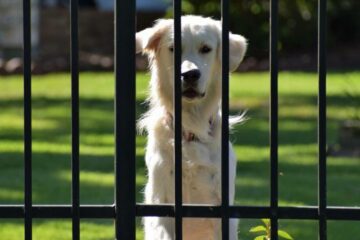Are Corn Snakes Poisonous to Dogs? What to Do (Right Away)!
Are corn snakes poisonous to dogs? Just how careful do you need to be about them? In this article, we’ll teach you everything you need to know to keep your dog safe, whether the snakes are pets or out in the wild. We’ll cover what to do if a corn snake bites your dog and the command you’ll need to keep future encounters safe.
Next, we’ll cover can a corn snake kill a dog while also instructing you on where corn snakes live and what corn snakes look like so you’ll know exactly what you’re dealing with. We’ll then go over if corn snakes and dogs can live together before finally finishing with how to keep corn snakes away from your home. Keep reading!
Are Corn Snakes Poisonous to Dogs?

Corn snakes are not poisonous to dogs. Known for their docile nature and vibrant colorations, corn snakes are non-venomous constrictors often found in the pet trade. They pose no toxic or venomous threat to dogs, humans, or any other animals.
Are Corn Snakes Venomous?
Corn snakes are not venomous. They belong to a larger group of snakes known as rat snakes, which are characterized by their non-venomous nature. Instead of using venom to paralyze or kill their prey, corn snakes, like all constrictors, wrap their bodies around their prey and apply pressure, causing suffocation.
This mechanism allows them to tackle and consume their prey. While a corn snake can deliver a bite if threatened or mishandled, the bite, although potentially painful, does not contain venom and is not life-threatening.
Are Corn Snakes Dangerous to Dogs?
Corn snakes are dangerous to dogs, though they pose no venomous threat. This mainly concerns the possibility of a provoked corn snake delivering a defensive bite. While such a bite would not inject venom, it could cause discomfort to the dog and there’s a risk of secondary infection if the wound is not properly cleaned and treated.
Additionally, smaller snakes could pose a choking hazard if a dog were to try and ingest them. For these reasons, you absolutely must prevent unsupervised interactions between your dog and a corn snake, or indeed any snake.
How to Train “Leave It” Command
To ensure your dog’s safety around snakes and other potential hazards, you can train them to respond to the “Leave It” command.
- Start with a treat in both hands. Show your dog one enclosed fist with the treat inside, and say, “leave it.”
- Ignore the behaviors your dog tries to get the treat. Once they stop trying, give them the treat from the other hand.
- Repeat this process until your dog moves away from the first fist when you say, “leave it.”
- Next, only treat your dog when they look up at you after moving away from the first fist.
- Once your dog consistently responds to the command with treats, practice it in different situations with different objects.
These steps will get your dog to stay away from corn snakes, but it’s important to remember that the underlying behavioral issues (prey drive, aggression, dominance, etc.) that were causing all of this to begin with will still be present. And until you address those, any positive changes you see are only going to be temporary.
“Well, how do I make these changes last?”
By getting your dog to truly choose to follow your direction, that’s how. I tried many times to write out how you can do that before deciding it made more sense to just link you to the free video series that explains it better than I’d ever be able to.
The series is by a man named Dan who is one of the world’s leading dog obedience trainers. In it, he teaches you how to put an end to things like when your dog bothers corn snakes and all other misbehavior using his fast and easy-to-follow methods.
In the first video, Dan will reveal to you why the two most common methods of dog training only doom you to failure. You can watch the video now by clicking here. Follow the proven system he’ll show you in his series and you’ll never have to spend another second worrying about your dog getting too close to corn snakes ever again!
Can a Corn Snake Kill a Dog?

A corn snake cannot kill a dog. Corn snakes, while capable of delivering a defensive bite, are non-venomous constrictors and pose no life-threatening danger to dogs. It’s important, however, to note that any snake bite should be treated promptly to prevent possible infection. Dogs should always be supervised when in the vicinity of any snake, including the relatively harmless corn snake.
Do Corn Snakes Bite Dogs?
Corn snakes do bite dogs, but this is unusual and typically only occurs if the snake feels threatened or cornered. Corn snakes are known for their generally docile nature, and they would much rather flee than engage in a confrontation. Their bites, although potentially uncomfortable due to their small, sharp teeth, are not venomous and should not pose a significant health threat to a dog.
However, that doesn’t mean that a bite should be ignored. Like any open wound, it should be cleaned and treated promptly to prevent infection. In case of a bite, the area should be washed with warm soapy water and then disinfected. If the dog shows any signs of distress, a fever, or if the wound seems to worsen over time, immediate veterinary care should be sought.
Corn Snake Bit My Dog
If a corn snake bit your dog, don’t panic. As mentioned, corn snakes are non-venomous, and their bites are not life-threatening. After ensuring your dog is calm and removing them from the vicinity of the snake, you should clean the bite area thoroughly.
- Wash the area with warm, soapy water.
- Apply a pet-safe disinfectant or a mild antiseptic.
- Keep an eye on the bite area for signs of infection, such as redness, swelling, or pus.
- If any of these symptoms appear, or if your dog starts behaving oddly or seems particularly distressed, seek veterinary care immediately.
As a proactive measure, learning the “Leave It” command is very useful in these situations. Learn how to do it in the first section. This will ensure your dog’s safety around snakes and other potential hazards.
You should get this handled now so that your dog will also be safe if they encounter other types of snakes or critters. They will then know how to behave so that you don’t have to worry about if king snakes are dangerous to dogs, what to do if a copperhead bites your dog, are black snakes poisonous to dogs, what to do if a rat snake bites your dog, if milk snakes can kill a dog, or what to do if a garter snake bites your dog.
What Do Corn Snakes Look Like?

Corn snakes, scientifically known as Pantherophis guttatus, are typically orange or brownish-yellow, with large, black-edged red blotches down the middle of their back. They may also exhibit stripes or a combination of stripes and blotches. Adult corn snakes usually reach a length of 24 to 72 inches, with a slender body, a clear belly, and a spear-shaped pattern on their head.
Where Do Corn Snakes Live?
Corn snakes are native to the southeastern United States, but their range extends as far north as New Jersey and as far west as Kentucky and Louisiana. They’re incredibly adaptable and can be found in a variety of habitats, including overgrown fields, forest openings, trees, abandoned buildings, and farms.
They are also quite commonly found in suburban areas and even in human homes. Their name “corn snake” comes from the fact that they were often found in corn cribs and grain stores, where they hunted rodents. It’s important to note that although they’re often seen as pests, corn snakes play a crucial role in controlling rodent populations in their natural habitats.
Are Corn Snakes Nocturnal?
Corn snakes are primarily diurnal, meaning they are active during the day. However, during hotter periods, they may become more nocturnal to avoid the extreme heat. This switch in their activity pattern allows them to regulate their body temperature and remain active when their prey is most available.
When Are Corn Snakes Most Active?
Corn snakes are most active during the warmer months, usually from March to November, depending on the region. They often hibernate during the cold winter months in a state known as brumation. However, during the active season, they are usually seen during the early morning and late afternoon when the temperature is mild.
In captivity, they may display increased activity during dawn and dusk, which is known as crepuscular behavior. These shifts in activity are part of their adaptive behavior to better hunt their prey, mainly rodents, birds, and bird eggs.
Corn snakes are non-aggressive and can make fascinating pets, but like any animal, they should be treated with respect and caution, and their needs for a suitable habitat and diet should be carefully met.
Learn to control your dog’s behavior around corn snakes by going back to the first section.
Can Corn Snakes and Dogs Live Together?

Corn snakes and dogs can live together, provided they are introduced properly and supervised closely. It’s very important to ensure both the snake’s safety and your dog’s well-being, as interactions could lead to stress or potential injury for either party.
- Proper Introductions: Slow and gradual introductions are important when getting your dog and corn snake accustomed to each other. Start by allowing your dog to smell the snake’s enclosure without the snake inside. This helps your dog get familiar with the new scent. Over time, your dog can be in the same room as the corn snake’s enclosure, always under close supervision.
- Supervised Interactions: It is never advisable to leave your dog and corn snake together unsupervised. Dogs are naturally curious and might disturb the snake or its habitat. Simultaneously, even though corn snakes are generally docile, they can become defensive if they feel threatened, which could lead to injuries for both parties. Learn the command you’ll need to control your dog’s behavior by going back to the first section.
- Snake Safety: Corn snakes should always be kept in secure enclosures to prevent any possible escape attempts and to ensure their safety from curious dogs. The enclosure should have a lock to prevent your dog from accidentally opening it.
- Health Considerations: Regular veterinary check-ups for both your corn snake and your dog are crucial to keep them in optimal health. Dogs can carry bacteria that are harmful to reptiles, and vice versa. Therefore, proper hygiene and care are paramount in households where dogs and corn snakes live together.
In conclusion, while corn snakes and dogs can live together, it requires careful management, constant supervision, and a commitment to the health and safety of both pets. Remember, each animal is an individual, and successful cohabitation will depend on the temperament and personality of your specific dog and corn snake.
How to Keep Corn Snakes Away
To keep corn snakes away, you should focus on making your environment less appealing to them by removing food sources, potential hiding spots, and access points into your home. This involves maintaining cleanliness, managing pests, and sealing up any cracks and crevices in your home’s structure.
- Eliminate Food Sources: Corn snakes primarily feed on small rodents like mice and rats. If you have a rodent problem, addressing this issue can go a long way toward deterring corn snakes. By using traps or hiring pest control services, you’ll make your home less attractive to these snakes.
- Remove Hiding Spots: Corn snakes, like most reptiles, love hiding spots. Overgrown shrubs, piles of firewood, leaf litter, and other debris provide excellent shelter. Regularly trimming vegetation and keeping your yard tidy can discourage corn snakes from taking up residence.
- Seal Entry Points: Ensure that all potential entry points to your home are sealed off. This includes gaps under doors, openings around plumbing, cracks in the foundation, and spaces around windows. Regular maintenance can help keep your home secure.
- Use Natural Repellents: Some natural scents, such as cinnamon and clove oil, are believed to repel snakes. You can make a DIY snake repellent by mixing these oils with water and spraying them around your property. However, the effectiveness of these natural repellents can vary, and they should not be relied upon as the sole method of deterrence.
Keeping corn snakes away is largely a matter of managing your environment effectively. By removing food sources, hiding spots, and access points, you can make your property far less appealing to these reptiles. As always, if you have a significant problem with corn snakes or other wildlife, consider consulting with a professional pest control or wildlife removal service.
Learn to control your dog around corn snakes and other critters by going back to the first section.
I’m sure you’re ready to not worry about any issues between corn snakes and dogs anymore, so I’ll let you get started on things now. Good luck with all of this, and thanks for reading our article “Are Corn Snakes Poisonous to Dogs? What to Do (Right Away)!”





